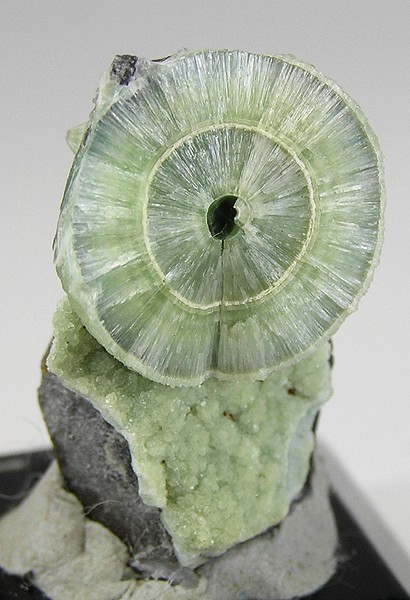The Mineral wavellite

Wavellite is a classic radiating mineral, forming spectacular pinwheel aggregates emanating from a central core in spherulitic balls. When the balls are complete, the radial structure is internal and not usually visible. A crystal aggregate needs to be fractured to see and appreciate the outstanding radial habit of Wavellite. Wavellite was named in 1805 after William Wavell, an English physician who first discovered this mineral.
Chemical Formula
Al3(PO4)2(OH)3 · 5(H2O)
Color
Light to dark green, yellowish-green, yellow, brown, gray. Rarely white or colorless. May exhibit concentric multicolored zoning in radial cross-sections.
Crystal System
Orthorhombic
Properties
Streak
White |
Hardness
3.5 - 4 |
Transparency
Transparent to opaque |
Specific Gravity
2.3 - 2.4 |
Luster
Vitreous, pearly |
Cleavage
1,1;2,2 |
Fracture
Uneven |
Tenacity
Brittle |
Uses
Wavellite is mainly used as a collectors mineral.
Noteworthy Localities
Large and lustrous, cream to yellowish Wavellite comes from the Siglo Veinte Mine, Llallagua, Potosí Department, Bolivia. Good European localities include the Lichtenberg Mine, Ronneburg, Thuringia, Germany; the High Down Quarry, Filleigh, North Devon, England; and the Laharran Quarry, Tracton, Ireland.
The most important occurrences of this mineral are in Arkansas, with several different localities producing the most outstanding forms of Wavellite. The specific localities include Dug Hill, Avant, Garland Co.; Mauldin Mt., Montgomery Co.; Mt. Ida, Montgomery Co.; and Hot Springs, Garland Co.
Large and bright yellow and green Wavellite spheres are found in the National Limestone Quarry, Mount Pleasant Mills, Snyder Co., Pennsylvania; and a deep green form comes from Slate Mountain, El Dorado Co., California.
Common Mineral Associations
Quartz, Limonite, Variscite, Crandallite, Muscovite
Distingushing Similar Minerals
Prehnite - Occurs in different environments, harder.
Smithsonite - Effervescent in hydrochloric acid, occurs in different environments.